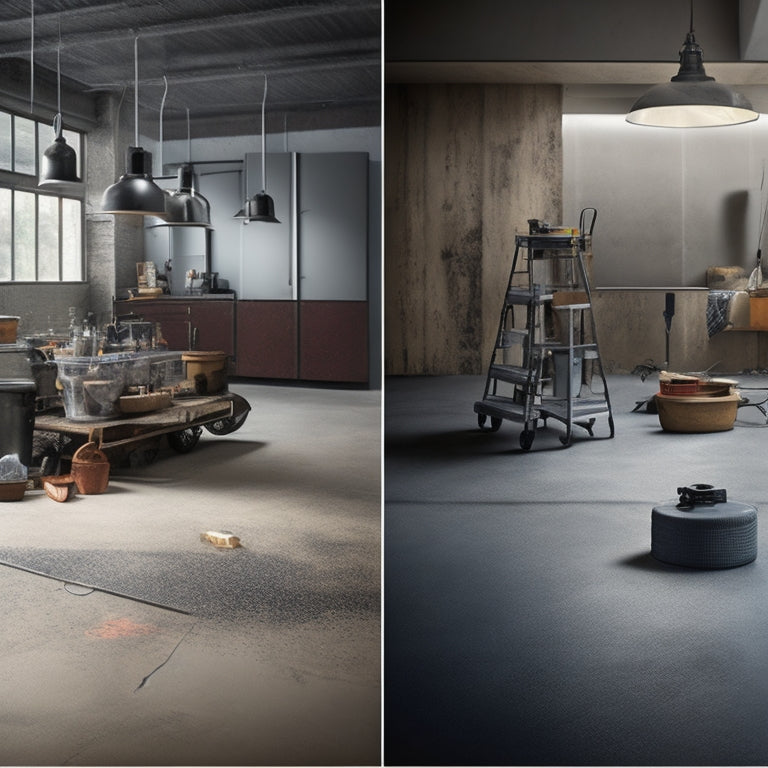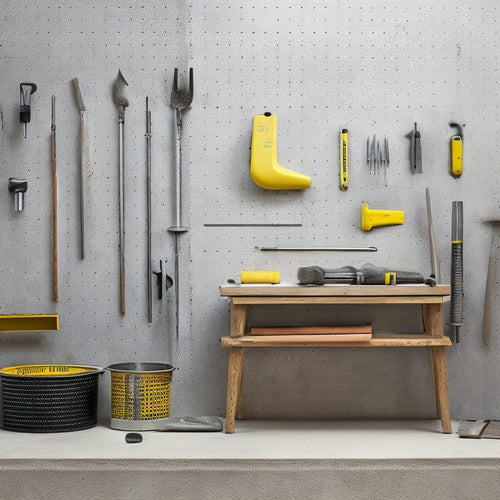
Top Tools for Revamping Old Concrete Floors
Share
You'll need a range of tools to revamp your old concrete floor, starting with epoxy, acrylic, or polyurethane paint, each with its own strengths and cost considerations. Surface preparation is essential, so invest in a concrete primer, cleaning solutions, and sanding equipment to guarantee a smooth surface. Don't forget to remove old paint and stains using chemical strippers, mechanical methods, or eco-friendly solutions. Once you've prepared the floor, it's time to paint with rollers, brushes, or paint sprayers, and finish with a sealant that provides moisture resistance, UV protection, and slip resistance - and there's more to explore in the world of concrete floor renovation.
Key Takeaways
• Invest in high-quality paint tools, including rollers, brushes, and paint sprayers, to ensure a smooth and even finish.
• Choose the right paint type, such as epoxy, acrylic, or polyurethane, based on the floor's condition, traffic, and desired finish.
• Prepare the surface properly by cleaning, priming, and repairing cracks and holes to ensure maximum paint adhesion and durability.
• Use specialized tools, like chemical strippers, mechanical methods, and eco-friendly solutions, to remove old paint and stains effectively.
• Consider adding a decorative sealant with moisture resistance, UV protection, and slip resistance to enhance the floor's appearance and safety.
Best Tools for Painting Over Old Concrete
When tackling a concrete floor painting project, you'll need the right tools to guarantee a smooth, even application and a professional-looking finish.
The first step is to choose the right paint type for your project. Epoxy, acrylic, and polyurethane paints are popular options, each with its own strengths and weaknesses. Epoxy paint is durable and resistant to chemicals, while acrylic paint is versatile and easy to clean up. Polyurethane paint offers a glossy finish and excellent abrasion resistance.
Next, you'll need to select the right application techniques and tools. Rollers, brushes, and sprayers are all effective methods, depending on the size and complexity of your project. For large, open areas, a roller with an extension pole is ideal. For smaller, more intricate spaces, a high-quality brush is a better choice. Consider investing in a paint sprayer for a smooth, even finish.
Don't forget to prep your surface with a concrete primer to promote maximum adhesion and durability. With the right tools and techniques, you'll be well on your way to achieving a beautiful, long-lasting finish that will give you the freedom to enjoy your newly revamped concrete floor.
Removing Old Paint and Stains
As you prepare to revamp your old concrete floor, you'll need to remove old paint and stains to guarantee a smooth, even finish.
You'll want to strip away old coatings, taking care to select the right method for the type of paint or stain you're dealing with.
Strip Old Coatings Away
Stripping old coatings away reveals the concrete floor's original surface, allowing you to assess its condition and plan for any necessary repairs before applying a new finish. This vital step in surface preparation is often overlooked, but it's fundamental for a successful revamp.
You'll need to remove old paint, epoxy, or other coatings that may be hiding cracks, stains, or other imperfections. For coating removal, you can use chemical strippers, which break down the old finish, or mechanical methods like grinding or sanding, which physically remove the coating.
Be certain to follow safety protocols when working with chemicals, and always test a small area first to verify the stripper or mechanical method won't damage the concrete.
Once you've stripped the old coating, you'll be left with a clean, bare surface that's ready for inspection and any necessary repairs. With a clean slate, you can move forward with confidence, knowing your new finish will adhere properly and last for years to come.
Effective Stain Removal Methods
Take on stubborn stains and old paint by deploying a targeted arsenal of stain removal methods, each tailored to tackle specific types of imperfections.
You'll need a combination of eco-friendly solutions and advanced techniques to effectively remove old paint and stains from your concrete floor.
For oil-based stains, try using a solvent-based cleaner, while water-based stains respond well to alkaline-based cleaners.
For more severe cases, consider using a chemical stripper or a high-pressure washer. Always follow manufacturer instructions and take necessary safety precautions when working with chemicals.
If you're dealing with old paint, use a paint stripper specifically designed for concrete floors. Be sure to choose an eco-friendly option that won't harm the environment or your health.
Once you've removed the old paint and stains, give your floor a thorough cleaning with a degreaser to remove any remaining residue.
With the right tools and techniques, you'll be able to remove even the toughest stains and old paint, leaving your concrete floor looking like new.
Preparing the Floor for Painting
Now that you've removed old paint and stains, it's time to prepare your concrete floor for a fresh coat of paint.
You'll need to clean the floor thoroughly to remove any remaining dirt or debris, and then fix any cracks and holes to create a smooth surface.
Next, you'll need to sand rough surfaces to guarantee a strong bond between the old concrete and the new paint.
Clean the Floor Thoroughly
Before applying a fresh coat of paint, scrub the entire floor to remove dirt, grime, and any existing sealers or coatings that may interfere with the new finish. This essential step guarantees a strong bond between the old concrete and the new paint.
You'll want to employ effective cleaning techniques to tackle tough stains and grout lines. For floor maintenance, use a degreaser or a heavy-duty cleaner specifically designed for concrete floors. Apply the cleaner according to the manufacturer's instructions and let it sit for the recommended time.
Then, use a stiff-bristled broom or a scrub brush to agitate the solution and lift away dirt and grime. Rinse the floor thoroughly with clean water to remove any residue.
If you're dealing with stubborn stains, consider using a pressure washer or a steam cleaner to blast them away. Once the floor is clean and dry, you'll be ready to move on to the next step in the painting process.
Fix Cracks and Holes
With the floor thoroughly cleaned, your next priority is to identify and repair any cracks and holes that could compromise the adhesion and appearance of your new paint job. This step is essential, as any imperfections can lead to a subpar finish.
Begin by inspecting the floor for cracks, no matter how small, and mark them with a piece of chalk or tape. Next, prepare your crack repair compound according to the manufacturer's instructions and apply it to the marked areas, using a putty knife to fill the cracks. For larger holes, you'll need a hole filling compound, which you'll apply in the same manner.
Once the compounds have dried, use a scraper or sanding block to smooth out the surface, feathering the edges to blend with the surrounding concrete. Confirm the area is level and even, as any bumps or ridges will show through the paint.
With the cracks and holes repaired, you can now move on to the next step, confident that your paint job will adhere properly and look fantastic. By taking the time to fix these imperfections, you're guaranteeing a professional-looking finish that will elevate your space and give you the freedom to enjoy your newly revamped concrete floor.
Sand Rough Surfaces
You'll need to sand the entire floor to create a smooth, even surface that's ideal for painting. This vital step in surface preparation guarantees a strong bond between the concrete and the paint, assuring a durable and long-lasting finish.
Begin by sweeping or vacuuming the floor to remove any debris or dust. Next, use a coarse-grit sandpaper (around 80-100) to aggressively sand the entire floor, focusing on rough areas and edges. As you progress, switch to finer sandpaper grades (120-150) for a smoother finish.
Be methodical and thorough, working in sections to maintain even coverage. Use a dustless sanding system or a vacuum with a HEPA filter to minimize dust and prevent it from settling back onto the floor.
Choosing the Right Paint Type
Selecting the right paint type for your concrete floor is essential, as it directly impacts the durability, appearance, and functionality of the finished surface. You want a paint that can withstand heavy foot traffic, resist stains, and maintain its color and sheen over time.
When choosing a paint, consider the following factors:
-
Epoxy alternatives: If you're looking for a more budget-friendly option, consider acrylic or polyurethane-based paints. These offer similar durability to epoxy paints at a lower cost.
-
Paint durability: Assess the level of wear and tear your floor will receive. If it's a high-traffic area, opt for a paint with high scratch resistance and abrasion tolerance.
-
Moisture resistance: If your floor is exposed to water or high humidity, choose a paint with moisture-resistant properties to prevent peeling or blistering.
- Color retention: If you want your floor to maintain its color and vibrancy, select a paint with UV-resistant properties to prevent fading.
Essential Painting Tools and Accessories
Once you've chosen the right paint type, it's time to gather the essential tools and accessories that will help you achieve a professional-looking finish on your concrete floor.
You'll need a range of specialized tools to guarantee a smooth, even application. Start with a high-quality roller extension pole, which will allow you to reach those hard-to-access areas without straining your back.
Next, invest in a set of premium roller covers, designed specifically for concrete floors. These covers will help you achieve a uniform finish and prevent the paint from seeping into the concrete's pores.
For those tight spaces and corners, consider using spray applicators, which provide precise control and minimize overspray.
Don't forget to grab a paint tray, paintbrushes, and a putty knife for any necessary touch-ups.
With these essential tools and accessories at your disposal, you'll be well on your way to transforming your old concrete floor into a stunning, like-new surface that exudes freedom and sophistication.
Finishing Touches and Sealants
After applying the paint, regularly inspect your concrete floor for any imperfections or areas that require additional coats, as a flawless finish depends on meticulous attention to detail. This is the perfect time to address any minor flaws, guaranteeing a smooth and even surface.
Next, it's time to add the finishing touches with decorative sealants. These not only protect your floor from wear and tear but also enhance its appearance. Consider using eco-friendly finishes that are gentle on the environment and your health.
Here are some key considerations for selecting the right sealant:
-
Moisture resistance: Choose a sealant that can withstand water and humidity to prevent damage and discoloration.
-
UV protection: Select a sealant that offers UV protection to prevent fading and discoloration caused by sunlight exposure.
-
Slip resistance: Consider a sealant with slip-resistant properties to guarantee safety, especially in high-traffic areas.
- Color enhancement: Opt for a sealant that enhances the color and vibrancy of your painted concrete floor.
Frequently Asked Questions
Can I Paint Over Epoxy or Polyurethane Coatings?
Can you paint over epoxy or polyurethane coatings? You'll need to exercise caution.
Before applying a new coat, guarantee the existing surface is properly prepared. Scrape off any loose material, clean the surface, and sand it to create a strong bond.
Coating compatibility issues can arise, so test the new paint's adhesion with a small patch. If it fails, you may need to strip the old coating or use a specialized primer.
Follow surface preparation tips to avoid costly rework and guarantee a successful revamp.
How Long Does It Take for the Paint to Fully Cure?
You're wondering how long it takes for the paint to fully cure.
The curing time depends on factors like temperature, humidity, and paint type.
Typically, most paints reach full cure within 7-14 days, but some may take up to 30 days.
To guarantee peak paint durability, follow the manufacturer's instructions and wait the recommended time before exposing the surface to heavy traffic or harsh conditions.
Are There Any Eco-Friendly Paint Options Available?
You're likely wondering if there are eco-friendly paint options available.
Yes, you'll find natural pigments and low VOC (volatile organic compound) paints that cater to your environmental concerns.
Look for labels like Greenguard Gold or EU Ecolabel, which guarantee the products meet strict emissions standards.
These eco-friendly options not only reduce your carbon footprint but also promote better indoor air quality, giving you the freedom to revamp your space while staying true to your values.
Can I Use a Roller Extension Pole for Painting?
When painting, you'll find that using a roller extension pole offers several benefits.
To begin with, it allows you to cover larger areas with ease, saving you time and energy.
Additionally, it enables you to maintain a consistent painting technique, ensuring a smooth, even finish.
Will the Paint Fade or Discolor Over Time?
You're wondering if the paint will fade or discolor over time. That's a valid concern!
The key to ensuring paint longevity lies in surface preparation. If you've properly cleaned and primed the concrete, the paint will adhere well and resist fading.
However, exposure to UV rays, heavy foot traffic, or harsh chemicals can still cause discoloration.
To minimize this risk, choose a high-quality paint with UV-resistant properties and apply a clear coat for added protection.
Conclusion
You've reached the final step in revamping your old concrete floors. With the right tools and techniques, you've transformed a dull, worn-out surface into a vibrant, modern space.
Did you know that, according to the American Coatings Association, the global concrete paint market is projected to reach $1.4 billion by 2025? This growing demand is driven by homeowners like you, who are keen to breathe new life into their concrete floors.
With these top tools, you're now part of this innovative trend, ready to enjoy your beautifully revamped floors for years to come.
Related Posts
-

10 Must-Have Tools for Concrete Repair Organization
You'll need a solid organization system to keep your concrete repair tools and materials within easy reach, protected...
-

5 Tips for Accurate Concrete Measurement Tools
To guarantee accurate concrete measurement, you'll want to calibrate your measuring tools regularly, choosing a frequ...
-

10 Best Tools for Sealed Concrete Finishing Success
When it comes to sealed concrete finishing success, you need a robust arsenal of specialized tools. Start with essent...


